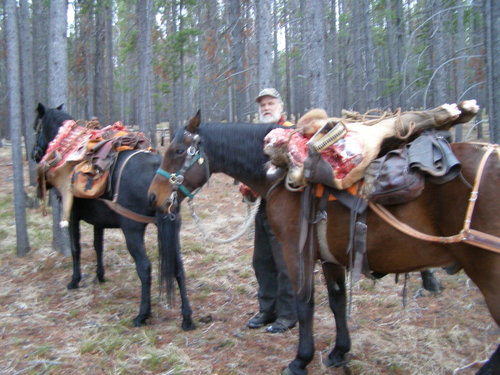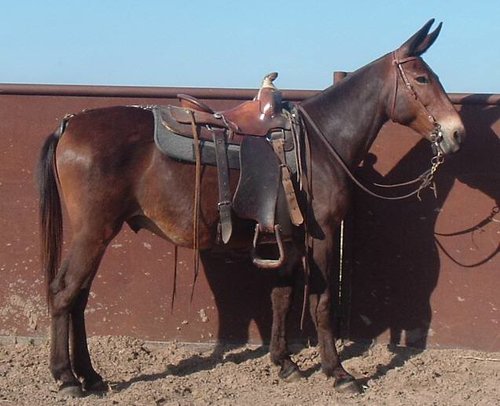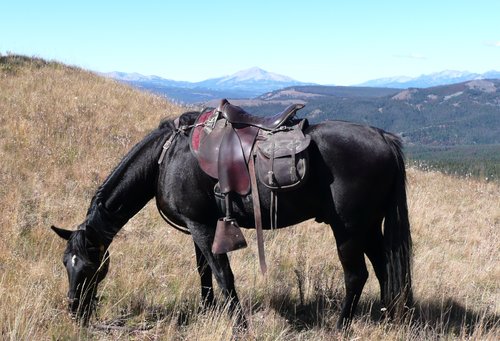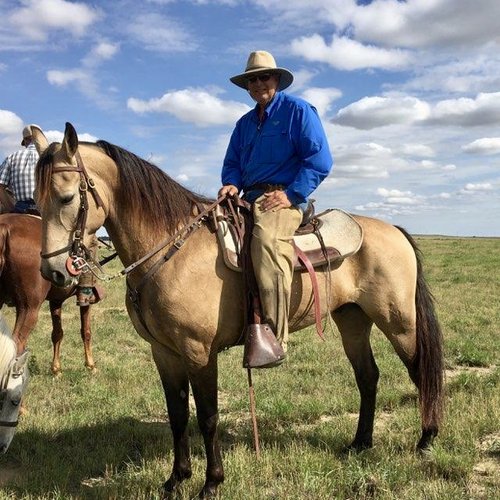diamond hitch
Well-known member
There are many ways to recover elk after shooting. As long as the elk is recovered there isn't a wrong way. What has worked for me over the years and by myself is probably the old way.
I cut about a four inch pole and tie it at head height between two lodgepole pines about 3-4 ft apart. Normally I use parachute chord but have used baling twine as I have a lot of it and it is strong. I fasten a block and tackle to the middle and then to the elk. I cut the lower legs off at the lower joint. Sometimes I bring in a single tree, sometimes I make a gimble out of a pole, and sometimes I pull the elk up by on leg and tie it to the pole. The I reset and pull the second leg and tie it to the pole so the legs are about 20-22 inches apart. Then I split the elk down the back to the ground and saw the elk in half the a little past the third rib. At that point I cut the front quarters off and set the hind quarters on the ground. I reset and attach the front half onto the pole and finish cutting the front in half to include about 3/4 of the neck. I cut the head off and lower the front quarters to prepare to load.
I run a 1/2 inch hemp rope through a hole down about 2 ribs. I set that quarter on the saddle, leg back hair to the horse. I bring over the second quarter, tie the rope from the first quarter through the second quarter and tie it off about 8-10 inches apart and push the first quarter off the saddle and center the package in the seat. I run the rope end around the horn with a half hitch and then down through a stirrup and back up. The rope rope then goes through the second stirrup and bring the two up high enough to support the quarters. Tie them off with a double half hitch on the horn. The trip through the stirrups acts the same as a lash cinch and controls the flopping if you have to start jumping logs.
The hind quarters are a little tougher. I place the first quarter in the saddle and tie the end of the rope around the rib section. I get the second quarter and place it on top of the first. The rope goes around the horn and snugs the first quarter to the pommel. Then I run the rope around the second quarter on the rib section and snug it to the pommel on the other side. The rope goes around the horn and back to the leg end. Leave enough slack so the cantle supports the top of the quarters. Return the rope to the horn and bring the stirrups up like the front quarters. The whole task typically takes me about an hour and a half and I'm old.

I cut about a four inch pole and tie it at head height between two lodgepole pines about 3-4 ft apart. Normally I use parachute chord but have used baling twine as I have a lot of it and it is strong. I fasten a block and tackle to the middle and then to the elk. I cut the lower legs off at the lower joint. Sometimes I bring in a single tree, sometimes I make a gimble out of a pole, and sometimes I pull the elk up by on leg and tie it to the pole. The I reset and pull the second leg and tie it to the pole so the legs are about 20-22 inches apart. Then I split the elk down the back to the ground and saw the elk in half the a little past the third rib. At that point I cut the front quarters off and set the hind quarters on the ground. I reset and attach the front half onto the pole and finish cutting the front in half to include about 3/4 of the neck. I cut the head off and lower the front quarters to prepare to load.
I run a 1/2 inch hemp rope through a hole down about 2 ribs. I set that quarter on the saddle, leg back hair to the horse. I bring over the second quarter, tie the rope from the first quarter through the second quarter and tie it off about 8-10 inches apart and push the first quarter off the saddle and center the package in the seat. I run the rope end around the horn with a half hitch and then down through a stirrup and back up. The rope rope then goes through the second stirrup and bring the two up high enough to support the quarters. Tie them off with a double half hitch on the horn. The trip through the stirrups acts the same as a lash cinch and controls the flopping if you have to start jumping logs.
The hind quarters are a little tougher. I place the first quarter in the saddle and tie the end of the rope around the rib section. I get the second quarter and place it on top of the first. The rope goes around the horn and snugs the first quarter to the pommel. Then I run the rope around the second quarter on the rib section and snug it to the pommel on the other side. The rope goes around the horn and back to the leg end. Leave enough slack so the cantle supports the top of the quarters. Return the rope to the horn and bring the stirrups up like the front quarters. The whole task typically takes me about an hour and a half and I'm old.








